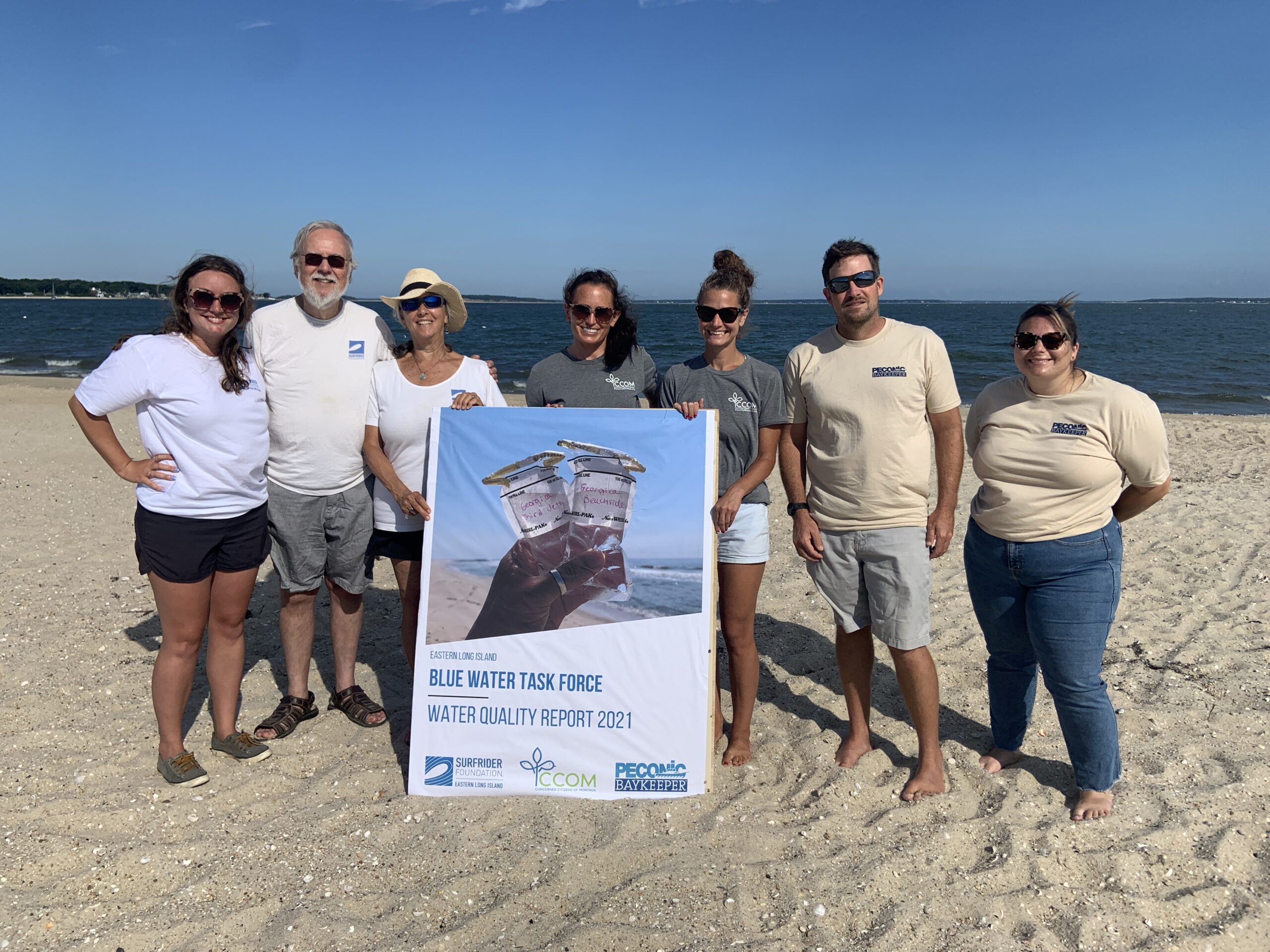
Members of three environmental organizations gathered at Long Beach in Noyac on Tuesday to mark the release of a report based on their collaborative effort to monitor water quality on the East End in 2021.
Staff members and volunteers working with the Surfrider Foundation’s Eastern Long Island Chapter, the Concerned Citizens of Montauk and the Peconic Baykeeper have committed to regularly collecting water samples from more than 70 locations, stretching from Lake Montauk to Conkling Point, near Greenport, in Southold Town.
Samples are taken not only at ocean and bay beaches but from creeks and other areas that may be more prone to water pollution and are not monitored by the Suffolk County Health Department’s own testing program, which is limited to bathing beaches.
“People don’t just go into the water at bathing beaches,” said Laura Tooman, the executive director of CCOM, adding they may unwittingly go wading or kayaking in a creek that has elevated bacteria levels.
The testing program helps “to give people the information they need so they can make sound decisions on when and where to swim,” she said, “but also to facilitate change. When there are locations where our samples have shown problems, we have been able to take the data and go to the town and clean up those sites.”
“The ocean beaches and open bay beaches tend to be pretty clean,” added Peconic Baykeeper Peter Topping, “but we are covering a lot of different areas.” The testing effort “fills in gaps” in the county’s own program “and creates awareness that we do have water-quality issues,” he said.
The results, collected under the umbrella of the Blue Water Task Force, are posted regularly on Surfrider’s website, at bwtf.surfrider.org. Last year, 1,625 samples were collected, up from 1,313 tests processed in 2020.
The full 2021 water-quality report can be found at easternli.surfrider.org.
“The Blue Water Task Force is the Surfrider Foundation’s volunteer science program that generates critical water quality information in coastal communities around the country to inform safe beach-going and to raise awareness of local pollution problems so solutions can be found,” said Jenna Schwerzmann, Eastern Long Island Chapter coordinator for the Surfrider Foundation, in a release.
Water samples are tested for the presence of enterococcus, a fecal bacteria that indicates the presence of human or animal waste in the water and other pathogens that can make people sick. Results are compared to the health standard set by Suffolk County for beach closures of 104 colony-forming units of enterococcus per a 100-milliliter sample (104 cfu/100mL).
Perhaps not surprisingly, the results show that many East End sites see high bacteria levels that exceed the county health standard for beach closures. Although such results are to be expected in creeks and areas that experience a high volume of stormwater runoff or in smaller enclosed bodies of water with high waterfowl populations, the report concludes that “the number of sites that show high bacteria levels on a consistent basis where people are recreating … is concerning.”
A number of recreational sites consistently show elevated levels of pollution, including East Creek in Lake Montauk, the Georgica Pond kayak launch on Montauk Highway in East Hampton, and in Sagg Pond in Sagaponack. All three locations showed excessively high bacteria levels in more than half of the samples collected.
The report notes that high rates of bacteria at several beaches and sampling sites could be attributed to a few different factors. Stormwater runoff carries pollutants like car oil, dust, animal waste, lawn fertilizers and pesticides into coastal bays, ponds, and ocean.
Likewise, heavy rain can cause flooding and cause groundwater levels to rise, which is particularly problematic on the East End, where most residences and businesses are serviced by cesspools and septic systems. These systems need an adequate amount of space between their drain fields and the groundwater in order to properly treat wastewater and filter out bacteria and pathogens. When a heavy rain occurs, untreated wastewater can leach out of cesspools and septic systems polluting both ground and surface waters.